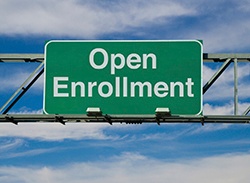 Break out the packets, slideshows, and enrollment forms - renewal and open enrollment season for January 1st is fast approaching! In the coming weeks, CFOs and human resources professionals will be meeting with their trusted consultants to make final decisions on their employee benefits packages for the upcoming plan year. As the numbers are finalized and decisions are communicated with the respective carriers, you can hear an audible sigh of relief that another year of renewals has come and gone. But it’s not over yet. One of the most important parts of the renewal process has just begun – open enrollment!
Break out the packets, slideshows, and enrollment forms - renewal and open enrollment season for January 1st is fast approaching! In the coming weeks, CFOs and human resources professionals will be meeting with their trusted consultants to make final decisions on their employee benefits packages for the upcoming plan year. As the numbers are finalized and decisions are communicated with the respective carriers, you can hear an audible sigh of relief that another year of renewals has come and gone. But it’s not over yet. One of the most important parts of the renewal process has just begun – open enrollment!
According a recent report from the Bureau of Labor Statistics, on average employee benefits make up a little over 30% of the overall compensation for an employee in the private sector. In the public sector, this number jumps to approximately 36%. Even though these are significant pieces of compensation, many employees don’t understand what benefit these offerings truly bring to themselves and their families. Some of this is due to a lack of engagement in open enrollment and persistence of ongoing benefit communications throughout the year.
How can we stop the confusion, increase engagement in employee benefits, and make open enrollment as effective as possible? Consider the following employee engagement strategies; they can put you on the right path towards a truly successful open enrollment.
Make Your Meetings Mandatory (Engagement, Active vs. Passive Enrollment)
Many open enrollment struggles begin with the fact that many employees are not engaged with their benefits offerings. One great place to start is to “force” employees to learn about their benefits by making open enrollment meetings mandatory. In doing so, you can give a streamlined and consistent message to all employees on the benefits offerings, overall benefits strategy, and what they truly mean to their families. Using active enrollments (requiring people to elect benefits every year) versus passive enrollments (enrollments roll over if no action is taken) is also another great way to make sure that employees take a closer look at their benefits offerings each and every year.
Keep it Short, Keep it Simple (Interactive)
Long winded printed communications and verbal presentations are a constraint to any effective open enrollment. Keep your open enrollment meetings to around 30-45 minutes. Printed and electronic materials should be short, concise, and focused on main points for the plan year. While it’s important to make the meetings and communications interactive, overloading employees with too much information is an easy way to lose interest and overall engagement.
Go Green!
Printed communications can be very useful to help convey benefits information. However, many employees tend to forget or lose benefits materials before they ever make it home to the entire family. As more and more Americans have access to the internet, email, and smartphones, endless information is at employees’ fingertips! Many apps and internet-based programs exist that can be configured to display your benefits information year-round. Not only does this help get the message home to the entire family, but could also save human resources some time in answering simple benefits related questions.
Make Open Enrollment a Year-Long Strategy
Employees use benefits year-round, so why should communications be restricted to open enrollment time? Newsletters, posters, emails, text messages, or even short videos released to employees periodically can help remind employees of benefit plan design or cost-saving features that can be easily forgotten if not frequently communicated. Company breakrooms and intranet pages are also great places to display pertinent benefit communications throughout the year. Constant reminders are key to any effective benefits communication strategy. Don’t forget to share info with spouses as well, especially if they are enrolled in your benefits plans!
Consumerism is the Future
With the staggering cost of health care and an inflationary trend that easily outpaces the general economy, the future of medical care is a serious concern. One of the reasons this is occurring is the lack of understanding of the true cost of health care by consumers. This trend is reversing with the growing implementation of high deductible health plans. Consumers are starting to see the real cost of health care, as more and more out of pocket costs are shifted to employees. Price-shopping and quality comparison tools are great resources to help your employees and your health plan save money not only in the short run, but also in terms of future overall plan viability!
We’re geared up and ready for open enrollment season at Gibson, are you?




